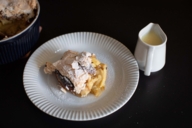
Sweet bread and real winter apples - that's what you should look for in a real Bavarian Scheiterhaufen. Here's the recipe from Sven Christ.
Separate one of the eggs and set aside the egg white in the fridge. Mix the egg yolk with the remaining eggs as well as the milk, cream, vanilla, cinnamon and two tablespoons of sugar. Cut the currant buns into slices approx. 1-2 cm thick. Peel, quarter and core the apples, then slice them thinly. Now turn the slices of bread/bun in the wet mix and arrange a layer of them in an ovenproof dish, followed by a layer of apple; repeat until it’s finished.
Preheat the oven to 170°C. Whisk the egg white with a mixer until stiff, then add the icing sugar and a little lemon juice. Continue whisking until it becomes a meringue and stands in nice peaks. Leave the scheiterhaufen to bake for 10 minutes, then spread the meringue on top and bake for a further 15 minutes. Scheiterhaufen should be eaten warm, and I love it served with vanilla sauce or custard. Many people are happy with just the apple filling, but without the vanilla sauce it’s not quite perfect for me.
You can find my recipe for authentic vanilla sauce here!
“Mehlspeise” is a word and concept that is peculiar to German-speaking regions, most particularly southern Germany and Austria. It describes a substantial main course that also happens to be sweet. It may have come about because of the tradition of fruit cultivation in these regions, with apples, pears and plums growing in abundance – to such an extent, perhaps, that they warranted equal standing with savoury main dishes.
Another particularity of Bavarian cuisine can be seen in the care people take to use up their scraps – which leads us directly to scheiterhaufen. Scheiterhaufen sounds like it might be something rather grim, given that the word translates as “funeral pyre”, but the name in fact refers to pieces of soaked sweet bread, which are piled up much like logs.
„Scheiterhaufen sounds like it might be something rather grim, given that the word translates as “funeral pyre”, but the name in fact refers to pieces of soaked sweet bread, which are piled up much like logs.“
I never enjoyed the taste of the scheiterhaufen I was given as a child – it was greasy and felt like eating bread noodles with sugar and a bit of apple sauce. But now I know what mistake my mother made: the apples need to be baked together with the rest of the dish, and it is best to use milk rolls or currant buns – at a push you could manage with a classic “sternsemmel” type of roll.
But leftovers like old baguettes or extra-crispy bread rolls are completely unsuitable because they taste too sour and the crust is too dominant. Unfortunately we only had baguettes at home, as my parents loved French cuisine. My mum meant well when she made her scheiterhaufen with baguette, but I can tell you it simply doesn’t work.
We will be using milk rolls or currant buns instead – they are a bit harder to come by, but it’s worth it. Although you might use croissants or similar to make ofenschlupfer or kirschmichel – the Swabian cousins of today’s dish – for scheiterhaufen itself, only sweet bread rolls will do and nothing else. That’s how to make it taste great.
The apples are baked as part of the dish. Of course Boskopp is the best apple variety to use, but Gala will do in a pinch. Peel the apples and cut them into slices. Most people add milk to the beaten egg, but you could instead add some cream or a dollop of crème fraîche. You can use raw cane sugar for a slightly healthier approach, but not muscovado as the taste is too strong.
The apples need to be baked together with the rest of the dish, and it is best to use milk rolls or currant buns – at a push you could manage with a classic “sternsemmel” type of roll.
Now the basic rules are clear, let’s get to the detail that transforms your bakery leftovers into a delicacy: the secret is a little frosted cap of meringue that splinters delicately when you cut into the dish, and which adds such lightness to the scheiterhaufen that you will be tempted to skip the plate and spoon it straight from the dish to your mouth. But hold your horses – you want to also add a dollop of vanilla sauce. You’ll remember the authentic, custard-like vanilla sauce from my dampfnudel recipe.
My own scheiterhaufen, the “new arrival” in the family, was also met with enthusiasm – my daughter, who was somewhat sceptical after a few mediocre encounters with the dish in her school canteen was already grabbing a second helping before I had even sat down. Fluffy, sweet, with a little sugary crunch and mild tanginess of the apples – it just works. That’s how a good scheiterhaufen should taste – and it means we’re also correcting slight imperfections in dishes that have been passed down from generation to generation.
At first glance, Café Aroma on Pestalozzistraße does not look like the sort of place that is dedicated to traditional Bavarian desserts, but I know they serve a scheiterhaufen that has wowed so many guests who keep going back for more. I must visit sometime to see if it also has a meringue crust. Even if it doesn’t, that doesn’t matter – people love it, otherwise they wouldn’t talk about it so excitedly.